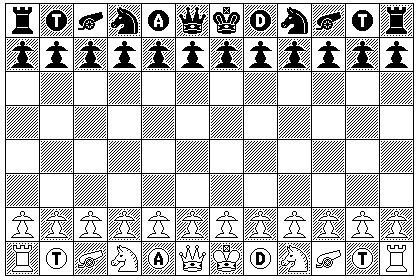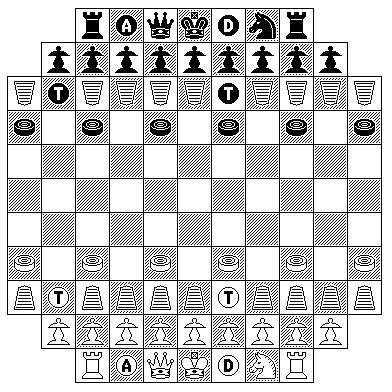
This form of Chess was inspired by thinking about the additional difficulty of forcing checkmate in the version of Hexagonal Chess devised by Władysław Gliński.
If it is difficult to checkmate the opponent's King, why not make it possible to win by capturing the opponent's King... by adding to the game a piece that can make two moves in a single turn?
That is what is done in the form of Chess the initial layout of which is shown below:

The order of pieces on the back rank is: Rook, Tiger, Cannon, Knight, Attacker, Queen, King, Defender, Knight, Cannon, Tiger, Rook.
The Tiger we have seen before; it moves as a Bishop, and captures as a Knight.
The Cannon is the same as the piece from Chinese Chess; it moves as a Rook, but captures along Rook lines by jumping over one piece which may be a friendly piece or an enemy piece.
The other new pieces, adjacent to the Queen and King where the Bishops normally would be, are the Attacker and the Defender.
The Attacker may move once per turn as a Bishop or as a Knight.
In addition, if the Attacker's first move was not a capture, the Attacker may make a second move. If the Attacker's first move was as a Bishop, the second move may be that of a Bishop or a Knight; if the Attacker's first move was as a Knight, the second move must be that of a Bishop.
If the Attacker places the opponent's King in check on its first move, it may capture that King on its second move and win the game in this fashion, just as checkmate wins the game.
However, the Attacker's power is countered by the Defender, which can also move twice in a turn.
While the Attacker's extra move is considered to take place after a player's normal turn, the Defender's extra move is considered to take place before a player's normal turn.
When one player moves his Attacker for the first time in a turn, the other player may, before that player makes his second move of his Attacker, move his Defender.
Therefore, the capture of the King on the Attacker's second move can be blocked by interposition, but only interposition of the other player's Defender.
The Defender's move is only one square in any direction, the same as that of the King.
As well, as the Attacker may move a Knight's move away from the opponent's King on its first move, the Defender has one additional power: it may move to its own King's square, thus exchanging places with the King, if the King is on a square adjacent to it. This places the Defender en prise to the Attacker, but if the Attacker takes it, it would then be en prise to the opponent's King on the next turn.
Furthermore, if the Defender has not moved in response to the opponent's Attacker move on the Attacker's previous turn, the Defender may be moved (without compromising its ability to respond to an Attacker move on the opponent's next move) prior to a player's regular move, which may be a second move of the Defender, or a normal move of any other piece. (The Attacker's second move cannot follow a first move of another piece, on the other hand.)
Thus, for example, if one is moving one's King to another part of the board, one can precede each King move with a Defender move, to keep both pieces together without slowing the King down.
Pawns may promote to Attackers or Defenders, in addition to Tigers, Cannons, Rooks, Knights, or Queens, but not, of course, to Bishops.
Castling is as in normal Chess; the King moves two squares to either side, and then the Rook in that direction hops over the King, as long as nothing is between them and neither have moved before.
Because the Attacker can win the game by capturing the King (it is also possible for an Attacker to give check on its second move, and thus win a game through normal checkmate, like any other piece) there is an important subtle change in how one of the most basic rules of Chess works.
A piece cannot move so as to expose its own King to check, even to give checkmate. The rationale for that is obvious. If a player checkmates the opponent's King, that allows that player to capture that King on his own next move; if his own King is now in check, his King can be captured on the move before, so the move should lose the game rather than winning.
Clearly, this reasoning does not apply, however, if the game is won by capturing the opponent's King. Therefore: if the Attacker is moving so as to win the game by capturing the opponent's King, the Attacker's first and second moves are both legal even if they expose its own King to check. (If it weren't for the fact that the Defender can only move one square, so interposition cannot affect any check it would give, exposing one's own King to check from the opponent's Defender would make the first move of the Attacker illegal in a two-move sequence to capture the opponent's King.)
And the Attacker and the Defender could also be added to the game described on the previous page

to allow for an interesting variant with a number of unusual possibilities of move added to the usual ones of Chess.
More recently, an online discussion of the change in the moves of the Queen and the Bishop that changed the game of Chess from its ancient form to the modern form we play today, inspired me to think of a much less radical way to change Chess to reduce the number of draws.
I tend to think, though, that this variant is something of a failure; it seems to me that it may "dumb down" the game of Chess, which is definitely not what I want. However, for cases like hexagonal chess and especially three-dimensional chess, such an extreme measure as this variant involves to make checkmate easier may be useful.
Here are the three changes to Chess that this variant involves:
Of course, though, since the Queen can move when placed en prise, checkmate still requires some work, but the fact that it now has such a limited move as well helps things along. Ideally, one would like to use something like a fork (of the King and Queen) or a discovered check (that also attacks the Queen), or a discovered attack on the Queen (that also gives check), to attack both the King and the Queen at once, so that while the Queen could move, it would be too late to rescue the King.
Another option, that does allow putting the King in check on the next turn, would be to pin the Queen against the King. Placing the Queen en prise and attacking all the other squares to which it can move also works for that, but that is similar to, and almost as difficult as, conventional checkmate. And, unlike checkmate, it may only last for one turn: the Queen can still move, and then on the next turn, it may have a square to which it can move where it is not en prise.
Of course, to make things a bit more fair, although such a change would be somewhat counter-productive, maybe the Queen as well as the King ought to be allowed to castle! Or, since making checkmate easier may make White's first-move advantage loom larger, only allow Black's Queen to be castled.
Also, given that the rules for Castling reflect the fact that the King may not be captured, but instead may not be moved into check, it seems to me, based on the way I understand the principles behind the rules of Chess, that Castling the Queen should have a slight difference: when the Queen is moved two squares in Castling, then on the next move, it should be possible to capture the Queen en passant along with the Rook now on the square it passed over by capturing that Rook, instead of Castling the Queen being simply forbidden in the circumstance of it crossing a square on which it would have been en prise.
Two other possible changes to the rules have come to mind.
It could be that, when one player captures the other player's Queen, if the option of removing the Queen from the board is taken, that forces the player whose Queen has been captured to promote to a Queen when promoting a Pawn for the next time.
As this provides a way to drastically weaken an opponent's offensive capabilities, however, this changed rule seems highly counter-productive, and hence inappropriate, for a variant focused on making checkmate happen more often.
One way to solve that would be to have this changed rule only apply if a player had Castled. By providing a penalty for Castling, this would encourage playing aggressively. Castling the Queen would also incur the penalty.
However, this eliminates giving only Black the ability to Castle the Queen as a way to counter White's first move advantage. That, too, could be fixed, by having this penalty for Castling only apply to White.
The other possible additional rules change for this variant would be to replace the two Bishops by Augmented Tigers.
The Tiger moves as a Bishop, but captures, and gives check, as a Knight. In this way, when a Tiger captures, it raises issues similar to that of a doubled Pawn resulting from a Pawn capture.
But remember that two Bishops can force checkmate, while two Knights cannot (and a Bishop and Knight can force checkmate, but it's very difficult).
So, for this variant, to prevent checkmate from becoming more difficult, replacing the Bishops by Augmented Tigers instead addresses that.
An Augmented Tiger moves without capturing as a Bishop, and captures as a Knight, but gives check as either a Knight or a Bishop. Thus, this change doesn't further reduce the forces of each player able to give checkmate beyond the reduction due to the drastic change to the Queen's move that has already taken place.
It may be important for players to avoid accidentally giving Stalemate instead of Checkmate by forgetting that the Augmented Tiger still gives check as a Knight in addition to giving check as a Bishop.